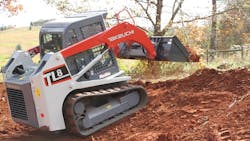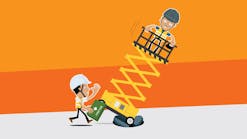Nektar Data Systems, a Canadian data management company that provides a data-management solution through a customizable platform with a cloud-based development backbone used in several downloadable apps, has published a solid top 10 list of safety tips for incident prevention.
1. Blind spots
Heavy equipment operators have to be 100 percent sure that no one is behind them or in their blind spots when moving, even if this involves getting out of the machine and checking. If vision is limited, have a spotter stand in a safe, visible position to guide and direct you. Inform those working around you for the day of your blind spots and require them to make eye contact with you before coming in the equipment’s vicinity. High-visibility vests are mandatory on all sites.
Read also: Onboard cameras elevate job site safety
2. Communication
Always be in constant communication with the people working around you. A two-way radio is the best form of communication; if that option is not available then use hand signals from a spotter who has been properly trained. Communication with operators should be touched upon at every safety meeting and reinforced by the foreman on site.
3. Seatbelts
Wearing your seatbelt in heavy equipment is just as important as in a moving motor vehicle. There is no excuse but laziness for not wearing it at all times. Not only will it save your life in the case of a rollover, but it also keeps you firmly in your seat when operating on rough terrain, saving energy, and reducing close calls by the end of a long day.
4. Mounting and Dismounting
Falls and stepping on and off are some of the biggest causes of injury recorded by OSHA and other safety departments. This includes entering and exiting the cab of a machine. A good rule of thumb is to always maintain three points of contact when getting on or off of your equipment. Never jump. Remember, the three-point rule requires three of four points of contact to be maintained with the vehicle at all times—two hands and one foot, or both feet and one hand. If handholds or steps are damaged, replace them; it could prevent a major injury down the line.
5. Loading/Unloading Equipment
Always be sure to be on level ground when loading or unloading your equipment. It greatly reduces the risk of rollovers or sliding off the low-bed ramps. If you are unloading on a busy job site or high traffic area, make sure people are clear of the unloading area and use a spotter to guide you.
Read also: Tips for safe transport of equipment
6. Overhead and Underground Hazards
Before work starts on any job site, all overhead obstructions such as power lines and low clearance should be identified and flagged. Call 811 to be sure underground utilities such as water, sewer, gas, and electrical are located by the appropriate department and marked with color-coded paint and flags. Play it safe when getting close to the underground utility and hand dig to uncover. When leaving holes that workers or the public can fall into, be sure to set up barriers and snow fencing.
7. Lock-out/Tag-out
In accordance with OSHA, employers must train and have procedures in place to ensure that before any employee performs servicing or maintenance on a machine where unexpected start-up or release of stored energy could occur and cause injury, the machine or energy source must be rendered inoperative. This includes hazards such as pinch points, attachments, and raised loads. Picture warnings, locks, and tags are to be used to prevent any incidents.
8. Load Limits
Be aware of the load limits of varying equipment when operating different machines throughout the day. Depending on the equipment set-up and size the load limits can change drastically. When lifting objects with a machine, make sure loads are secure with the proper rigging attachments, and always inspect to ensure they are in good working condition. As with most equipment operations, confirm all workers are at a safe distance when lifting and moving loads.
9. Walk-around Inspection
Equipment should be inspected at least once daily before operating. This involves walking around with a predeveloped checklist of components to check for good working order. Hydraulic hoses, undercarriage, oil levels, stress points, etc., are all areas that need to be inspected and reported to the maintenance/safety department before machine start-up. Using a cloud-based mobile device to complete a task such as this can greatly improve communication and response time between operator and mechanic.
10. Knowing Your Limits
Operating heavy equipment can be a stressful job at times even for a seasoned veteran. Never put yourself in a situation you don’t feel comfortable in, regardless of your instructions. Get out of the cab and look around if you’re unsure about working on a slope or around hazards. Staying calm and alert throughout the day will allow you to be more productive and will translate to a positive working environment for those around you.
Nektar reminds us that this list is only a general guideline of things to keep in mind. Accidents can happen, but most are preventable incidents. Having regular safety meetings, up-to-date procedures, and training will keep incidents down and workdays more efficient.





